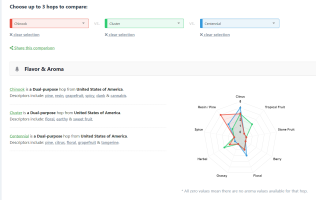Certain hops claims to have notes of pineapple, peach, stonefruit, etc. , but I do not get that experience. Is it my process, or are my 43 year old taste buds losing it?
I don't think you're losing it, but before I assail you with my decades of brewing "knowledge," I feel like I should disclose some of my biases so that you know where I'm coming from. If you're not interested in that, jump down to the third paragraph.
Don't take advice on NEIPAs from me, I've never brewed one and I have very little experience with them, they just don't appeal to me as a style. Please understand, I'm not knocking them! It's a style that brings joy to a lot of people (more joy is always better) and I'm in awe of the technical prowess that is needed to brew this style. I think they're great, but I don't brew them so I don't drink them.
With that out of the way, here's what I have to say. As someone that has brewed for three decades, I think contemporary hop descriptions have become laughably useless. Listen, I understand that as our knowledge grows so, too, must our language grow to accommodate that knowledge and allow us the ability to discriminate between ever more subtle concepts, but things are getting a bit silly.
It's worth coming up for air from time to time and thinking critically about our more complex language. When we start using descriptors like "lychee," "mango," kiwi," "passionfruit," etc. are we actually transmitting data by using those terms? Each of those fruits are unique, but it's fair to say that within the larger universe of fruits, they're clustered in a neighborhood of fruits that are noteworthy for their sweetness rather than their acidic or aromatic content. Within the context of a contemporary IPA that uses at least three, often many more, hop strains are these subtle differences noticeable? I'd ask are they even worth noting?
As a brewer, I'd emphatically answer, "Nope." If I were a hop farmer, I'd say, "But mine also has plucky hints of dragonfruit!!!!!"
Gone are the days when the emergence of a new hop variety from the glacial USDA program really was big news. Now that the farmers are running their own breeding programs (more power to them!), each season sees a few new hops and those farmers have a lot of money riding on those acres, so their marketing departments keep ratcheting up the language each season. Unfortunately, that has left a lot of homebrewers dejectedly staring at their pints wondering, "Where is the pineapple? The cotton candy? The lychee? The tangerine? The grapefruit? The blood orange? The dank? I was supposed to be teased by subtle notes of kiwano...and I don't even know what the hell that is!"
Again, I think we need to come up for air. For the most part, hops taste like hops. Sure, there are differences between Hallertau and Saaz, Cascades and Amarillo, and HBCXXX and HBCYYY. At the end of the day, though, they're hops used in a very complex system that starts way, way, way before we even design our grists, water, hop bills, and processes. We like to kid ourselves that we have a lot of control in our breweries. That's bollocks, the bulk of the work that defines our beers was done in the fields and in the maltsters and the oasts...and is largely compromised by the logistics train that results in those products winding up in our Vittles Vaults and freezers.
So, is your failure to detect "naughty notes of lemon grass" proof that you're losing it? Absolutely not!
Like me, my suggestion to your problem is boring. Pick a generic grist, then pick a hop bill that you like and brew it relentlessly, making single adjustments along the way, until you slowly have that grist and hop bill exactly right.
It's a lot more fun chasing "it" hops, I'll concede. But there are no silver bullets, no magic hops, no chemistry-defying yeast strains in brewing. There's only slow, dogged repetition and incremental progress.
I hope you found this useful.
Edit: Also, I like to keep my freezer as empty as possible (by homebrewer standards). If I find a pound of hops that I like, I want to be able to turn around and buy a lot more of that hop. Not all crops are the same, not by a long shot, and pellet hops keep for years if stored in the freezer under vacuum.


















































![Craft A Brew - Safale BE-256 Yeast - Fermentis - Belgian Ale Dry Yeast - For Belgian & Strong Ales - Ingredients for Home Brewing - Beer Making Supplies - [3 Pack]](https://m.media-amazon.com/images/I/51bcKEwQmWL._SL500_.jpg)










